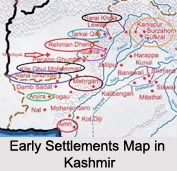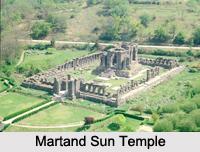 Early History of Kashmir Valley is stressed from the evidences of anthropological era. The Archaeological Survey of India proved that Kashmir Valley is the place where human dwell more than 10000 years before.
Early History of Kashmir Valley is stressed from the evidences of anthropological era. The Archaeological Survey of India proved that Kashmir Valley is the place where human dwell more than 10000 years before.
Human Settlement in Kashmir Valley
It was in the time, when there was no civilisation, no government and no administration in the world, Kashmir was the place where the human races began to make a new era of their civilisation, now in oblivion.
Burzahom Civilisation in Kashmir Valley
The earliest Neolithic sites in the flood plains of Kashmir valley are dated to C. 3000 BCE. Most important of these sites are the settlements at Burzahom, which had two Neolithic and one Megalithic phases. The first phase (C. 2920 BCE) at Burzahom is marked by mud plastered pit dwellings, coarse pottery and stone tools. In the second phase, which lasted till C. 1700 BCE, houses were constructed on ground level and the dead were buried, sometimes with domesticated and wild animals.
Occupation of the Early Human Settlement in Kashmir Valley
The humans of Burzahom civilisation earned their living from hunting and fishing. There was also the evidence of cultivation of wheat, barley, and lentils that have also been found in both the phases.
Megalithic Phase in Kashmir Valley
 In the megalithic phase, massive circles were constructed and grey or black burnish replaced coarse red ware in pottery. During the later Vedic period, as kingdoms of the Vedic tribes expanded, the Uttara Kurus settled in Kashmir.
In the megalithic phase, massive circles were constructed and grey or black burnish replaced coarse red ware in pottery. During the later Vedic period, as kingdoms of the Vedic tribes expanded, the Uttara Kurus settled in Kashmir.
Kashmir Valley during the Time of Alexander
In 326 BCE, Porus asked Abisares, the king of Kashmir, to aid him against Alexander the Great in the Battle of Hydaspes. After Porus lost the battle, Abhisares submitted to Alexander by sending him treasure and elephants.
Kashmir Valley in Ashokan Era
During the reign of Ashoka (304-232 BC), Kashmir became a part of the Maurya Empire and Buddhism was introduced in Kashmir. During this period, many stupas, some shrines dedicated to Shiva, and the city of Srinagari, which is now called Srinagar in Srinagar District of Jammu and Kashmir was built.
Kashmir Valley in Buddhism Era
Buddhism era began here with the hands of Ashoka in the later phase of his rule. Kanishka (127-151 CE), an emperor of the Kushan dynasty, conquered Kashmir and established the new city of Kanishkapur. The Buddhist tradition holds that Kanishka held the Fourth Buddhist council in Kashmir, in which celebrated scholars such as Ashvagosha, Nagarjuna and Vasumitra took part. By the fourth century, Kashmir became a seat of learning for both Buddhism and Hinduism. Kashmiri Buddhist missionaries helped spread Buddhism to Tibet and China and from the fifth century CE, pilgrims from these countries started visiting Kashmir. Kumarajia (343-413 AD) was among the renowned Kashmiri scholars who travelled to China. He influenced the Chinese emperor Yao Xing and spearheaded translation of many Sanskrit works into Chinese at the Chang`an monastery.
Kashmir Valley after the Attacks of Huns
 Hepthalites (White Huns) under Toramana crossed over the Hindukush Mountain Range in the later phase of early Indian history and conquered large parts of western India including Kashmir. His son Mihirakula led a military campaign to conquer all of North India. He was opposed by Baladitya in Magadha and eventually defeated by Yasodharman in Malwa. After the defeat, Mihirakula returned to Kashmir where he led a coup on the king. He then conquered of Gandhara where he committed many atrocities on Buddhists and destroyed their shrines. Influence of the Huns faded after Mihirakula`s death.
Hepthalites (White Huns) under Toramana crossed over the Hindukush Mountain Range in the later phase of early Indian history and conquered large parts of western India including Kashmir. His son Mihirakula led a military campaign to conquer all of North India. He was opposed by Baladitya in Magadha and eventually defeated by Yasodharman in Malwa. After the defeat, Mihirakula returned to Kashmir where he led a coup on the king. He then conquered of Gandhara where he committed many atrocities on Buddhists and destroyed their shrines. Influence of the Huns faded after Mihirakula`s death.
Development of Hinduism in Kashmir Valley
After seventh century, there are significant developments that took place in Kashmiri Hinduism. In the centuries that followed, Kashmir Valley produced many poets, philosophers, and artists who contributed to Sanskrit literature and Hindu religion. Among notable scholars of this period was Vasugupta who wrote the Shiva Sutras which laid the foundation for a monistic Shaiva system called Kashmir Shaivism. Till 1346, Kashmir Valley became the epicentre of Hinduism.
Related Articles
Jammu and Kashmir
Kashmir
Kashmir Valley
Early History of Kashmir
Medieval History of Kashmir
History of Jammu & Kashmir
Martand Temple
Dynasties of Ancient Kashmir



















